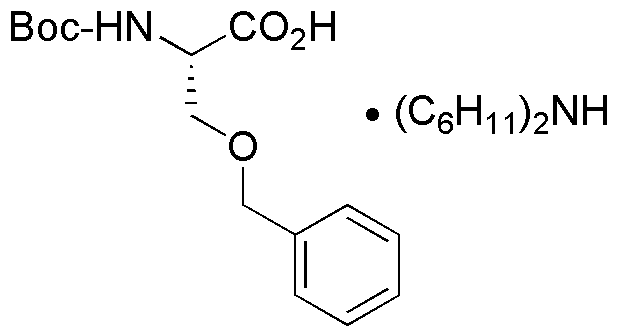Boc-O-benzyl-L-serine dicyclohexylammonium salt is widely utilized in research focused on:
- Peptide Synthesis: It serves as a protecting group in the synthesis of peptides, allowing for selective reactions without interfering with other functional groups. This is crucial for researchers aiming to create complex peptide structures.
- Drug Development: The compound is used in the formulation of pharmaceutical agents, particularly in designing drugs that target specific biological pathways. Its unique properties enhance the stability and efficacy of drug candidates.
- Bioconjugation: It plays a role in bioconjugation techniques, where it helps attach biomolecules to surfaces or other molecules, facilitating the development of targeted therapies and diagnostic tools.
- Protein Engineering: Researchers utilize it in the modification of proteins to improve their functionality, stability, or solubility, which is essential in biotechnological applications.
- Analytical Chemistry: The compound is employed in various analytical methods, including chromatography, to separate and analyze complex mixtures, aiding in quality control and research studies.
General Information
Properties
Safety and Regulations
Applications
Boc-O-benzyl-L-serine dicyclohexylammonium salt is widely utilized in research focused on:
- Peptide Synthesis: It serves as a protecting group in the synthesis of peptides, allowing for selective reactions without interfering with other functional groups. This is crucial for researchers aiming to create complex peptide structures.
- Drug Development: The compound is used in the formulation of pharmaceutical agents, particularly in designing drugs that target specific biological pathways. Its unique properties enhance the stability and efficacy of drug candidates.
- Bioconjugation: It plays a role in bioconjugation techniques, where it helps attach biomolecules to surfaces or other molecules, facilitating the development of targeted therapies and diagnostic tools.
- Protein Engineering: Researchers utilize it in the modification of proteins to improve their functionality, stability, or solubility, which is essential in biotechnological applications.
- Analytical Chemistry: The compound is employed in various analytical methods, including chromatography, to separate and analyze complex mixtures, aiding in quality control and research studies.
Documents
Safety Data Sheets (SDS)
The SDS provides comprehensive safety information on handling, storage, and disposal of the product.
Product Specification (PS)
The PS provides a comprehensive breakdown of the product’s properties, including chemical composition, physical state, purity, and storage requirements. It also details acceptable quality ranges and the product's intended applications.
Certificates of Analysis (COA)
Search for Certificates of Analysis (COA) by entering the products Lot Number. Lot and Batch Numbers can be found on a product’s label following the words ‘Lot’ or ‘Batch’.
*Catalog Number
*Lot Number
Certificates Of Origin (COO)
This COO confirms the country where the product was manufactured, and also details the materials and components used in it and whether it is derived from natural, synthetic, or other specific sources. This certificate may be required for customs, trade, and regulatory compliance.
*Catalog Number
*Lot Number
Safety Data Sheets (SDS)
The SDS provides comprehensive safety information on handling, storage, and disposal of the product.
DownloadProduct Specification (PS)
The PS provides a comprehensive breakdown of the product’s properties, including chemical composition, physical state, purity, and storage requirements. It also details acceptable quality ranges and the product's intended applications.
DownloadCertificates of Analysis (COA)
Search for Certificates of Analysis (COA) by entering the products Lot Number. Lot and Batch Numbers can be found on a product’s label following the words ‘Lot’ or ‘Batch’.
*Catalog Number
*Lot Number
Certificates Of Origin (COO)
This COO confirms the country where the product was manufactured, and also details the materials and components used in it and whether it is derived from natural, synthetic, or other specific sources. This certificate may be required for customs, trade, and regulatory compliance.


